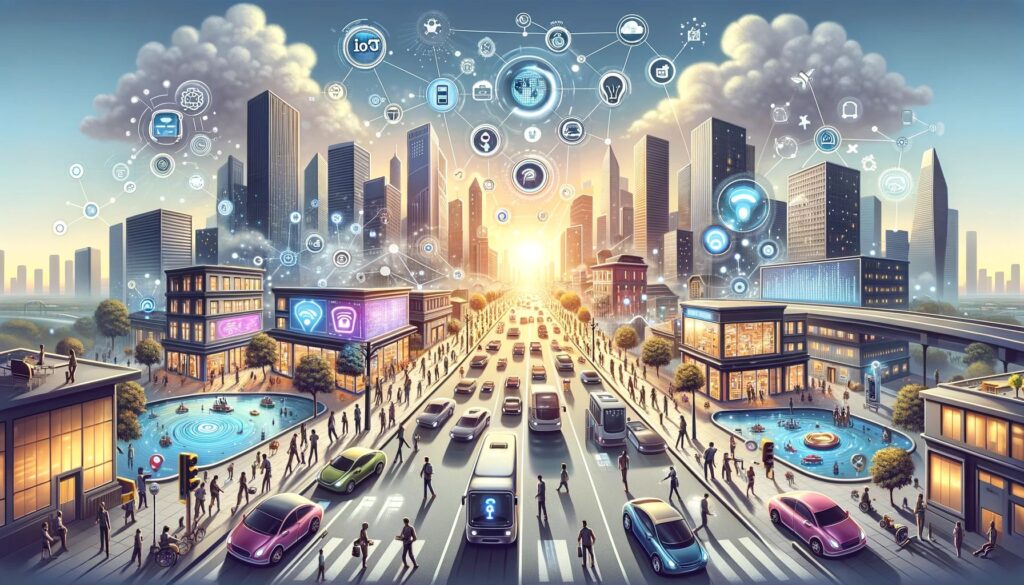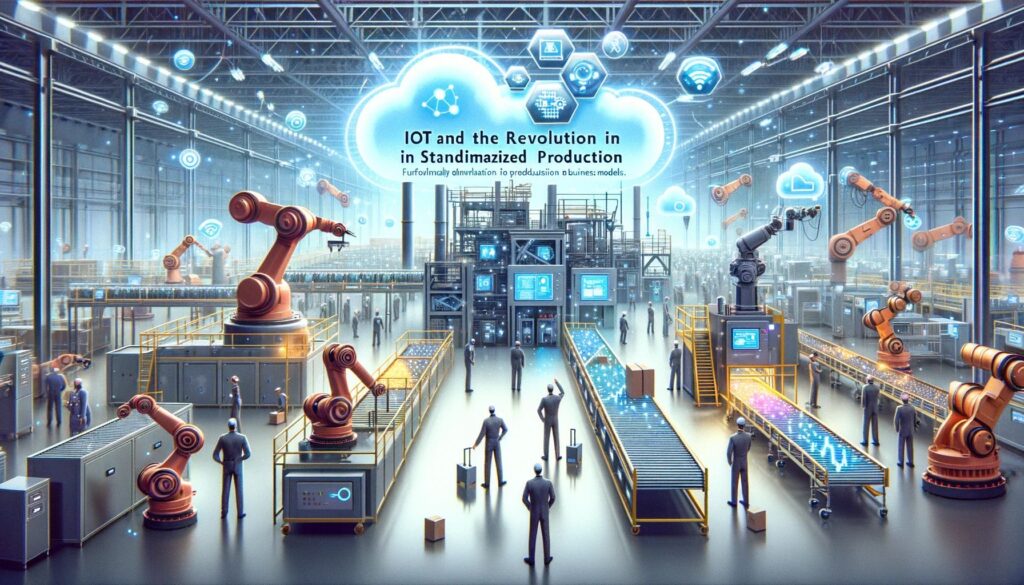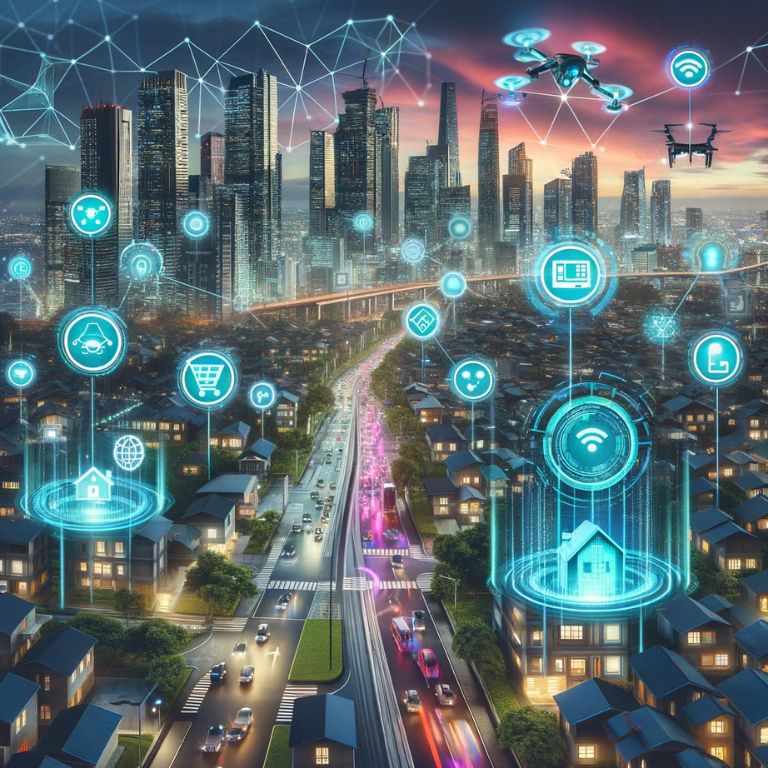Introduction to IoT: The Dawn of a Connected Era
The Internet of Things, commonly referred to as IoT, marks a transformative era in the digital revolution. This concept, at its core, is about connecting devices to the internet and to each other. From everyday items like refrigerators and thermostats to complex industrial tools, IoT encapsulates a network of physical objects embedded with sensors, software, and other technologies aimed at exchanging and acting on data. The implications of such a connected world are vast and varied, touching upon every sector from healthcare and agriculture to urban planning and manufacturing.
The inception of IoT can be traced back to the early 2000s, but it’s the last decade that has seen an explosive growth, thanks to advancements in affordable sensor technology, widespread internet access, and the exponential growth of data analytics capabilities. These elements combined have transformed a once speculative idea into a palpable force driving innovation and efficiency across the globe.
The Significance of IoT
IoT’s significance lies in its ability to provide real-time data and insights. This information, when processed and analyzed, can lead to smarter decisions, automated actions, and, ultimately, a more efficient and responsive environment. For instance, in the realm of smart homes, IoT devices can monitor energy usage, detect water leaks, and ensure security, thereby not only offering convenience but also promoting sustainability and safety.
In industrial settings, IoT becomes even more critical. It’s at the heart of the fourth industrial revolution (Industry 4.0), where it allows for what’s known as the ‘smart factory.’ Here, machinery and equipment can communicate to optimize production processes, reduce waste, and anticipate maintenance issues before they become critical. The result is a significant increase in efficiency, productivity, and safety.
The Evolution of IoT
As IoT continues to evolve, it’s being shaped by several key trends:
- Proliferation of Smart Devices: The number of IoT devices is skyrocketing. It’s estimated that by 2025, there could be over 75 billion IoT-connected devices worldwide.
- Advancements in AI and Machine Learning: These technologies are enhancing the capabilities of IoT devices, making them more intelligent and responsive.
- Increased Focus on Security: As the number of connected devices grows, so does the potential for security breaches. There’s a growing emphasis on developing more secure IoT systems.
Expansion into New Areas: Beyond traditional realms, IoT is expanding into areas like smart cities, where it’s being used to manage traffic, conserve energy, and improve public safety.
The Surge of IoT: Market Growth and Economic Value
The Internet of Things is not just a technological marvel; it’s a significant economic driver. The surge in IoT’s market growth is a testament to its transformative potential across various sectors. According to McKinsey & Company, the IoT’s economic impact could be as much as $11.1 trillion per year by 2025. Such projections highlight the enormous value IoT brings to the table, from increasing productivity and creating new business models to enhancing customer experiences.
Market Growth Dynamics
The growth of the IoT market is fueled by several factors:
- Decreasing Costs: The cost of sensors and connectivity has dropped significantly, making IoT more accessible and feasible across different sectors.
- Increased Connectivity: With more areas around the world gaining access to high-speed internet, including the advent of 5G, the potential for IoT expands exponentially.
- Technological Advancements: Innovations in AI, cloud computing, and data analytics are enhancing the capabilities and efficiency of IoT systems.
Economic Value Across Industries
IoT’s economic value is widespread, touching industries as diverse as manufacturing, healthcare, retail, and agriculture:
- Manufacturing: IoT is revolutionizing manufacturing through predictive maintenance, enhanced supply chain management, and the creation of smart factories that significantly boost efficiency and reduce downtime.
- Healthcare: In healthcare, IoT devices are used for everything from monitoring patient vitals remotely to managing inventory in hospitals, leading to improved patient outcomes and operational efficiencies.
- Retail: Retailers are using IoT for inventory management, enhancing customer experience, and creating personalized marketing strategies, all of which contribute to increased sales and customer satisfaction.
- Agriculture: IoT is making agriculture more precise and efficient through smart farming techniques that optimize resource use, improve crop yields, and reduce environmental impact.
Challenges in Realizing Economic Value
While the potential is immense, realizing the full economic value of IoT comes with its set of challenges. These include:
- Scalability: As companies move from pilot projects to full-scale IoT deployments, they face challenges in scaling their solutions while managing costs and complexity.
- Interoperability: With a myriad of devices and platforms, ensuring they can communicate and work together effectively is a significant hurdle.
Security and Privacy: Protecting the vast amount of data generated and ensuring user privacy is critical in maintaining trust and unlocking the economic benefits of IoT.
Emerging Trends in IoT for 2024
As we advance into 2024, the Internet of Things is poised to unfold new trends that promise to further its integration into our daily lives and enhance its impact across various sectors. These trends not only reflect the evolving technological landscape but also the changing needs and expectations of consumers and industries alike.
1. Advancement Towards 5G and Beyond
The rollout of 5G technology is a game-changer for IoT. With its promise of faster speeds, lower latency, and the ability to connect more devices simultaneously, 5G is set to unleash the full potential of IoT. This advancement means more reliable and efficient operations, particularly for critical applications in areas such as autonomous vehicles, telemedicine, and smart cities. As we look towards 2024, the expansion of 5G and research into 6G will further enhance IoT capabilities, making real-time data processing and analytics more robust and reliable.
2. Intelligent Data Analysis and Edge Computing
As IoT devices proliferate, the amount of data generated is staggering. To make this data useful, there’s a growing trend towards intelligent data analysis. Leveraging artificial intelligence (AI) and machine learning, IoT systems are becoming capable of not just collecting data, but also making sense of it and making decisions in real-time. Alongside, edge computing is gaining traction. By processing data closer to where it’s generated (at the edge of the network), it reduces latency and bandwidth use, which is crucial for time-sensitive applications.
3. Increased Focus on IoT Security
With the growing number of IoT devices, security is becoming an increasingly critical concern. In 2024, expect to see a continued emphasis on enhancing IoT security at both the device and network levels. This includes the development of more robust encryption methods, regular security updates, and the implementation of advanced threat detection systems to protect against hacking and breaches.
4. Integration of IoT in Smart Home Devices
Smart home technology is one of the most consumer-facing aspects of IoT, and its adoption is only expected to grow. From smart thermostats that learn your schedule to fridges that can order groceries, the integration of IoT in home devices is making lives more convenient and energy-efficient. In 2024, look for even more innovative smart home solutions, as well as increased interoperability among different devices.
5. Diverse Applications Across Industries
IoT’s applications are becoming more diverse and sophisticated. In healthcare, for example, wearable devices are enabling remote patient monitoring, while in agriculture, IoT is being used for everything from soil monitoring to livestock tracking. Manufacturing is seeing the rise of the Industrial Internet of Things (IIoT), with sensors and smart devices transforming production lines. Each industry is finding unique ways to leverage IoT to improve operations, enhance customer experiences, and create new business models.
6. The Rise of Consumer Privacy Awareness
As IoT becomes more ingrained in our lives, consumers are becoming more aware and concerned about their personal data. In response, companies are expected to place a greater emphasis on privacy, implementing more transparent policies and giving users more control over their data. This trend is not just about compliance with regulations like GDPR but also about building trust and a positive reputation among consumers.
The Integration of IoT in Daily Life

The Internet of Things is weaving itself into the fabric of daily life with increasing intricacy and sophistication. As we move into 2024, the integration of IoT in everyday activities is becoming more pronounced, providing enhanced convenience, efficiency, and safety. This section explores how IoT is transforming various aspects of daily life and what to expect as it continues to evolve.
1. Home Automation and Smart Living
Smart homes are perhaps the most relatable example of IoT integration in daily life. Devices like smart thermostats, lights, and security systems are becoming commonplace, offering homeowners convenience and energy efficiency. For instance, smart thermostats can learn your schedule and adjust the temperature accordingly, while smart lights can be controlled remotely or set to routines. As we progress, these systems will become even more integrated, with AI-powered assistants capable of managing multiple aspects of home management, from energy consumption to grocery shopping.
2. Wearables and Personal Health Monitoring
IoT’s role in personal healthcare is expanding rapidly. Wearable devices like fitness trackers and smartwatches are now capable of monitoring a range of health indicators, from heart rate and sleep patterns to blood oxygen levels. These devices not only provide real-time insights for the user but also collect data that can be shared with healthcare providers for better diagnosis and treatment. Looking ahead, these devices will likely become more sophisticated, offering more detailed health insights and possibly even early warnings about potential health issues.
3. Enhanced Mobility and Transportation
IoT is making significant inroads in improving mobility and transportation. Smart traffic management systems are reducing congestion and enhancing safety by optimizing traffic flow based on real-time data. Meanwhile, connected vehicles equipped with IoT sensors are paving the way for enhanced safety features and, eventually, fully autonomous driving. As we move forward, the integration of IoT in transportation will continue to evolve, potentially transforming how we navigate and manage urban environments.
4. Smart Cities and Urban Living
Smart cities are urban environments where IoT is used to improve efficiency, sustainability, and citizen welfare. IoT devices are used to monitor and manage everything from traffic and waste management to water and energy consumption. These systems not only improve operational efficiency but also contribute to a more sustainable and livable urban environment. As more cities adopt smart technologies, we can expect urban living to become more responsive and adaptive to the needs of its inhabitants.
5. Retail and Customer Experience
In the retail sector, IoT is revolutionizing the shopping experience. Smart shelves with RFID tags can track inventory in real-time, while IoT-enabled beacons can provide personalized promotions to shoppers as they navigate stores. For online shopping, IoT is improving supply chain efficiency, ensuring faster and more reliable delivery. As we look to the future, the retail experience will likely become even more personalized and efficient, with IoT at the center of this transformation.
6. Agriculture and Food Security
IoT is also making an impact in agriculture, helping to address food security challenges. Sensors can monitor soil moisture, crop health, and weather conditions, providing farmers with the data needed to make informed decisions. Automated irrigation systems, drones for crop monitoring, and connected machinery are all examples of how IoT is increasing efficiency and productivity in agriculture. As these technologies become more widespread, they will play a crucial role in ensuring food security in a changing world.
The Challenges of Scaling and Security
As the Internet of Things continues to expand into every corner of our lives and industries, it confronts significant challenges that must be addressed to realize its full potential. Two of the most critical challenges are scaling the technology to accommodate the ever-increasing number of devices and ensuring the security and privacy of the vast amounts of data they generate.
1. Scaling IoT Solutions
As IoT devices proliferate, scaling becomes a significant challenge. The ability to manage, process, and store data from billions of devices is a complex task that requires robust infrastructure and advanced technology.
- Infrastructure Demand: IoT devices require a massive backend infrastructure capable of handling increased data traffic, storage, and processing. As more devices come online, the strain on this infrastructure grows.
- Interoperability and Standards: With many different manufacturers and types of devices, ensuring they can all communicate and work together effectively is crucial. The lack of standardized protocols can hinder the scalability and full potential of IoT networks.
- Managing Complexity: As IoT systems become more complex, managing them effectively becomes more challenging. Companies must develop tools and systems that can handle the increasing complexity without compromising performance.
2. Ensuring Security and Privacy
With great connectivity comes great responsibility. The expansion of IoT increases the potential attack surface for cyber threats, making security a top priority.
- Data Security: IoT devices often collect sensitive data, making them attractive targets for cyberattacks. Ensuring the data is transmitted and stored securely is paramount.
- Device Security: Many IoT devices have limited computing power and may not support advanced security features. Ensuring these devices are not vulnerable to attacks is a challenge.
- Privacy Concerns: As devices collect more personal data, concerns about privacy and data misuse grow. Companies must ensure they’re using data responsibly and transparently, adhering to regulations and ethical standards.
3. Addressing the Challenges
Addressing these challenges requires a multi-faceted approach:
- Investment in Infrastructure: To scale effectively, significant investment in infrastructure, including more robust networks and cloud services, is necessary.
- Developing Standards: Industry groups and regulators must work together to develop standardized protocols and guidelines that ensure interoperability and security.
- Innovations in Security: Advancements in encryption, blockchain, and AI can help enhance the security of IoT devices and networks.
Regulations and Compliance: Governments and regulatory bodies need to establish clear guidelines and regulations to ensure data privacy and security.
IoT and the Revolution in Standardized Production

The Internet of Things is not only transforming our personal lives but is also revolutionizing standardized production processes across industries. This shift is characterized by increased automation, improved efficiency, and the creation of new business models, fundamentally altering the way products are manufactured and delivered.
1. Automation and Efficiency
IoT enables a higher degree of automation in production. Machines equipped with sensors can communicate and coordinate with each other, optimizing the manufacturing process. This not only speeds up production but also reduces errors and waste, leading to a more efficient and cost-effective operation.
2. Predictive Maintenance
With IoT, machines can predict and alert when they are likely to fail or need maintenance. This predictive maintenance prevents unexpected downtime, ensuring the production line runs smoothly and efficiently. It’s a shift from reactive to proactive maintenance.
3. Customization and Flexibility
IoT allows for greater customization and flexibility in production. Manufacturers can more easily adjust to changes in demand or customize products to individual specifications without significantly slowing down the production process.
4. Supply Chain Optimization
IoT provides real-time visibility into the supply chain, allowing companies to track materials, predict delays, and respond to issues as they arise. This leads to a more streamlined and resilient supply chain.
5. Challenges and Considerations
While the potential benefits are substantial, there are challenges to consider. Ensuring the security of IoT systems in production, managing the vast amount of data generated, and maintaining interoperability among various devices and systems are all crucial factors that need to be addressed to fully leverage IoT in standardized production.
Conclusion
The Internet of Things (IoT) promises a more connected and efficient future, with vast potential to enhance our lives and industries. However, realizing this future requires addressing challenges like security, scalability, and privacy. As we navigate the IoT landscape, a balanced approach is vital—embracing innovation while ensuring ethical and responsible use. By collaborating across sectors and focusing on these challenges, we can harness IoT’s potential responsibly, steering it towards a future that benefits everyone.




